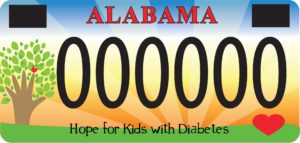“She had just started t-ball, and she was drinking just GALLONS a day . . . she could just never get enough to drink.” Ava’s mom, Ali, noticed the classic signs at first: increased thirst, increased urinary frequency. Ali thought at first that Ava had a urinary tract infection, so she took her to her pediatrician where a urinalysis revealed glucose in her urine. She was sent to the emergency department at Children’s of Alabama where she was subsequently diagnosed with Type 1 Diabetes.
An estimated 1.25 million Americans have Type 1 Diabetes (T1D), with approximately 40,000 new diagnoses each year. November is designated as National Diabetes Month, encompassing both classifications of diabetes: Type 1 and Type 2.
 Type 1 Diabetes develops when the body does not produce an important hormone called insulin. Insulin is made by the pancreas and is used to regulate blood sugar levels. For illustration, if someone eats a snack high in sugar or carbohydrates, the body recognizes this increased blood sugar and responds with insulin to help bring blood sugar levels back down to a safe range. In Type 1 Diabetes, insulin is not made by the pancreas, and so the body cannot effectively control blood sugar levels. People with Type 1 Diabetes use insulin to replace what their body does not make, and they rely on insulin replacement, via injections, to regulate blood sugar. While there is no specific, identifiable cause of Type 1 Diabetes, researchers believe risk factors might include autoimmune processes, genetic predisposition, and other environmental factors.
Type 1 Diabetes develops when the body does not produce an important hormone called insulin. Insulin is made by the pancreas and is used to regulate blood sugar levels. For illustration, if someone eats a snack high in sugar or carbohydrates, the body recognizes this increased blood sugar and responds with insulin to help bring blood sugar levels back down to a safe range. In Type 1 Diabetes, insulin is not made by the pancreas, and so the body cannot effectively control blood sugar levels. People with Type 1 Diabetes use insulin to replace what their body does not make, and they rely on insulin replacement, via injections, to regulate blood sugar. While there is no specific, identifiable cause of Type 1 Diabetes, researchers believe risk factors might include autoimmune processes, genetic predisposition, and other environmental factors.
Type 2 Diabetes is much more prevalent than Type 1, accounting for 90-95% of all diabetes diagnoses in the United States. Previously known as “non-insulin dependent diabetes”, Type 2 Diabetes differs from Type 1 in that the body does produce some insulin independently, but the body is not producing enough of the hormone, or the body is incorrectly using insulin that is made. Several factors might be linked to developing Type 2 Diabetes, though not directly causative, and include obesity, lifestyle, lack of physical activity, smoking, and genetic predisposition.
Regardless of the type of diabetes, complications from the disease can be significant and can affect a patient throughout their lifetime. Several major organ systems can be hugely affected by persistently high, unmanaged blood sugar levels. Nerve damage, or neuropathy, can occur in patients with uncontrolled blood sugar levels and manifests as pain, numbness, and tingling in fingers, hands, and feet. The kidneys can also take a hard hit from persistently high blood sugar levels, resulting in kidney damage that can be mild or as extreme as end-stage kidney failure. Patients with diabetes are at higher risk than the general population of having a heart attack, stroke, or other heart disease complication (See more complications here.).
Type 1 Diabetes usually presents in childhood, as it did with three-year-old Ava, though Type 2 Diabetes is becoming increasingly more common in children. After the initial period of shock at the diagnosis, Ali notes that Ava has done remarkably well coping with blood sugar checks and insulin injections. Of course, children ask questions, and Ava answers to the best of her ability as a now four year old: that her insulin pump “gives her super powers”. Ava’s parents make a point to allow her to eat like any normal child, but they control her portions of sweets and carbohydrates. These diet and lifestyle changes, originally made with Ava in mind, have become good for her entire family. They calculate her insulin needs, including Ava in the discussion, to adjust for what she needs to keep her blood sugar levels in check.

Of course, we as mothers want to protect our children from everything: bullies, illnesses, major life changes . . . I wish sometimes that I could put my own kids in a bubble and keep them away from parts of life going on around them. Ali describes the first few months after Ava’s diagnosis as emotionally difficult and an adjustment for their family. But one day, watching her daughter play on the ball field, she came to the following conclusion: “Yes, she has diabetes. Yes, she will have to deal with it every moment of every day. But that is not what she will be known for.” Ali has made it her mantra to allow Ava to do everything that other children are doing and still keep her diabetes under control: “She is like every other kid, she just has to take a couple of extra steps.” 
Along with over 2,600 other children in Alabama, Ava’s mom is thankful for the diabetes team at Children’s of Alabama. Ava is seen every three months at the endocrinology clinic at Children’s and is followed by a team of healthcare professionals, all working to keep her healthy and free of complications. Ali is able to keep in touch with Ava’s doctors by phone or e-mail, and can always rely on a prompt response from them if she has a question about managing Ava’s blood sugar levels.
I asked Ava’s mom what she would want other moms to know about her daughter with diabetes. “Teach your children to accept kids that have a special need.” Whether it be an insulin pump, a feeding tube, or anything else that might make a child unique, these kids with chronic illnesses are just like other children, and we all should encourage our children to make friends with those who are different instead of avoiding them.

We can all agree that love and friendship are the answers to everything the world might throw at us.
For more information on diabetes care at Children’s of Alabama, you can visit their website at www.childrensal.org/diabetes-center. You can even help support the endocrinology department with a specialty car tag, Hope for Kids with Diabetes, available when you renew your tag in person or online from the Alabama Department of Motor Vehicles. Of the $50 cost for one of the tags, $41.25 goes directly to the Division of Pediatric Endocrinology at Children’s of Alabama for research, physician training, and patient care.












